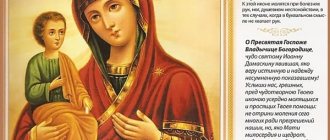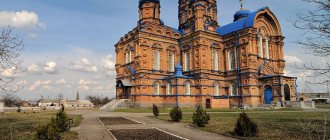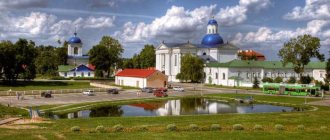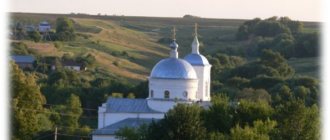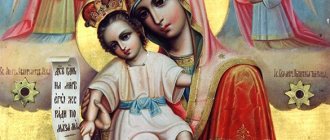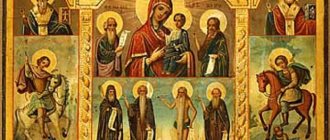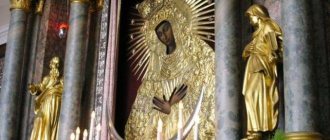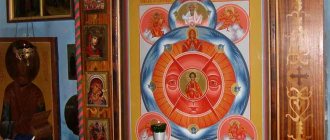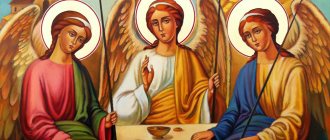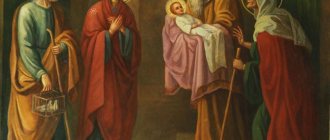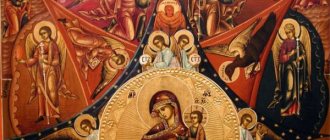0
(0)
The basis of the plot of the Prayer for the Cup is the prayerful appeal of Jesus to God the Father for humility in submission to his will. He is ready to accept the upcoming suffering and torment, but he trusts in the last will of the Almighty and asks to protect him from the cup of suffering prepared for him for the remission of the sins of mankind.
Fig. 1 Prayer in the Beautiful Garden of Gethsemane ends with the arrival of the guards and inevitable death awaits the Savior. Jesus, through his prayers, expresses readiness to accept the inevitable and complete submission to inevitable suffering.
During Holy Week, believers every day honor and remember in prayer the last days of the life of Jesus Christ. On certain days, specific events are praised. On Maundy Thursday, two days before the celebration of Easter, an appeal is made to the icon of the Prayer for the Cup. The plot images were created to describe the meaning and value of the spiritual world, to understand humility and accept the prepared fate. For the remission of sins, it is necessary to pray tirelessly, asking the Lord for forgiveness and remission of all sins.
Meaning of the icon
The main meaning of the icon of the Prayer for the Cup is Jesus’ appeal to his Father. He asks for forgiveness and remission of sins not for himself, but for all humanity. Throughout the entire plot, the plan of salvation is observed. The suffering of Jesus betrayed by Judas leaves no one indifferent. The image evokes compassion, sorrow, doubt and even fear among Christians.
The hands of the kneeling Lord are raised in prayer, he turns to heaven, where an angel gives him a golden cup, as the personification of suffering and death, for the salvation of humanity. The meaning of the image is to make people understand that prayer strengthens the spirit, restores lost strength, and instills love in the heart, even through torment and suffering.
Fig 2 Icon Praying for the chalice symbolizes the persistence of faith and belief that the human is always inextricably linked with the divine. Any torment and death must be accepted with humility, accepting all hardships and submitting to the will of God.
The icon helps those who are in difficult situations and who are losing their last hope. The Lord blesses you to search for the right paths and protects you from stupidity and bad deeds. With prayer, as the last hope in the Lord, you need to believe and hope for salvation. The Almighty helps everyone, preventing them from sinning or taking extreme measures.
Theological interpretation
Theologians see in the words of the Gethsemane prayer of Jesus confirmation that He had two wills: Divine (common with God the Father) and human (received in connection with His incarnation). Athanasius the Great believed that Christ’s prayer for the cup “shows two wills: human, characteristic of the flesh, and Divine, characteristic of God; and human, due to the weakness of the flesh, renounces suffering, but His Divine will is ready for it.”
The Gethsemane prayer of Jesus Christ, from the point of view of theologians, was an expression of His fear of death, inherent in human nature.
| When the human will refused to accept death, and the Divine will allowed this manifestation of humanity, then the Lord, in accordance with His human nature, was in struggle and fear. He prayed to avoid death. But since His Divine will wanted His human will to accept death, suffering became free according to the humanity of Christ. — John of Damascus |
Theophylact of Bulgaria in his interpretation of the Gospel of Matthew writes:
| He wants this cup to pass by, either as evidence that He, as a man, naturally turns away from death, as stated above, or because he did not want the Jews to fall into such a grave sin, which would have resulted in the destruction of the temple and the death of the people. He wants, however, that the will of the Father be done, so that we also know that we must obey God rather than fulfill our own will, even if nature urges us to do otherwise. Or for this purpose he prayed, so that the cup would pass by from Him, so that the sin would not be imputed to the Jews, just as Stephen, having learned from Him, prayed for those stoning him, so that it would not be imputed to them as a sin. |
There is an opinion that during the Gethsemane prayer the devil, who had departed from Jesus “for a time” after His temptation in the desert (Luke 4:13), again approached Him with temptations, trying to divert Him from the upcoming feat of the Passion of the Cross.
St. Maximus the Confessor strongly disagrees with the version of the sinful resistance of Christ’s humanity. He refutes the Nestorian thought of the Monothelites that the human component of the will of Jesus Christ manifested itself not from the moment of his incarnation, but only at the moment of prayer for the Cup and was rejected by the Divine component of his one theanthropic will: “Is there resistance when (Christ) prays and voluntarily accepts carnal weakness through tightness (sustolhv) and does not resist at all, but says: If it is possible and not what I want, but if what You want and adds to the tightness a strong impulse against death? He really captured ours in Himself, through a short-term natural struggle, in order to free us from it, and to confirm the nature of His own flesh...”
For the perfect human essence assumed by Christ (nature, identical to nature among the Chalcedonians and Severians), conscious resistance to God is inconceivable. This is confirmed by the fact that resistance is always “unnatural”, and as such sinful. And in the humanity of Christ, which exists “according to nature,” as St. Maximus the Confessor repeatedly emphasized, there is no active sin. Unlike the Platonists and Neoplatonists, following the Stoics, Justin the Philosopher and the great Cappadocians, St. Maximus always places a very high value on human nature, in particular, and on matter and created nature in general; after all, this nature, as God’s creation, is extraordinarily good (“very good”).
What does the Shrine pray for?
According to biblical legend, Jesus was arrested because of Judas' betrayal in the Garden of Gethsemane, the most beautiful place in Jerusalem. Jesus Christ knew about the fate prepared for him and earnestly prayed, “Let this Cup pass from me.” His ascension was so sincere and strong that bloody drops of sweat rolled down his face.
Orthodox Christians pray before the icon in the most difficult life situations, when there is a special need for the help and support of the Almighty. The Lord God takes despair away from faith, helps to find the right solution in difficult situations, gives consolation and strengthens the spirit. Prayer is most powerful during Lent, during Holy Week.
Fig. 3 Prayer to the icon Prayer for the chalice helps to overcome despair, anxiety, unreasonable fears and bad premonitions. Christians turn to the shrine for help in resolving difficult situations, financial problems, and legal proceedings.
The icon of the Prayer for the Chalice clearly represents the suffering and humility of the Savior of mankind, even at a moment of absolute hopelessness. Deep loneliness is combined with the awareness of the main purpose - the salvation of humanity. Therefore, when praying to the holy image, believers receive so much strength and peace. Ascension gives you self-confidence in fulfilling your plans, in the fact that all troubles will pass and justice will prevail.
Prayers to the Shrine
In most cases, before the icon of the Prayer for the Cup, the “Our Father” is read. However, it is permissible to exalt any holy text, even to use one’s own words. The Lord strengthens the spirit and faith, gives consolation and peace if one prays earnestly and stays awake. Diligent prayer with communion on Maundy Thursday helps to get rid of negative thoughts and experiences.
Fig 4 Prayer to the Holy Spirit promotes communion, the unity of believers with God, and helps cope with doubts and anxieties.
Our ancestors learned all the words of the prayer by heart, since many of them did not know how to read and write. Now you can use the prayer book, which contains all Orthodox prayers. Miniature copies of icons with prayers on the back are available for free sale in church shops. Many believers carry them with them as an additional talisman and protection.
Fig. 5 Thanks to prayer to the Most Holy Trinity, the person praying receives a blessing for important decisions, protection from accidents, and financial collapse.
The Prayer to the Holy Trinity in Church Slavonic is considered difficult to memorize, so beginners are advised to read it from the pages in order to correctly place stress and pronounce all the words and thereby not distort the essence of the holy petition.
Fig 6 The Lord's Prayer is one of the main holy texts with which you can address the Lord God. It can be read in front of any icon and for any vital need.
You can read the appeal to the icon of Prayer for the Chalice both in church and at home. Before starting prayer, you need to clear your thoughts, tune in to understanding the deep meaning of ascension to the Lord, and make the sign of the cross. You need to cross yourself three times at the end of the prayer.
Fig. 7 Prayer The Power of Faith carries within itself a hidden religious meaning, setting up a Christian to understand the tragedy that happened to Christ, about his sacrifice for the sake of all humanity.
Important! Frankly turning to God through prayer helps change your destiny for the better. It puts you in a friendly mood towards others, cleanses the soul from anger and envy, fills you with positive emotions, and instills faith in the heart.
Prayers in front of the icon Prayer for the chalice
Prayer to the Holy Spirit
Heavenly King, Comforter, Soul of truth, Who is everywhere and fulfills everything, Treasure of good things and Giver of life, come and dwell in us, and cleanse us from all filth, and save, O Good One, our souls.
Prayer to the Most Holy Trinity
Most Holy Trinity, have mercy on us; Lord, cleanse our sins; Master, forgive our iniquities; Holy One, visit and heal our infirmities, for Thy name's sake.
Lord's Prayer
Our Father, who art in heaven! Hallowed be Thy name, Thy kingdom come, Thy will be done, as it is in heaven and on earth. Give us this day our daily bread; and forgive us our debts, just as we forgive our debtors; and do not lead us into temptation, but deliver us from the evil one.
Symbol of faith
I believe in one God the Father, Almighty, Creator of heaven and earth, visible to all and invisible. And in one Lord Jesus Christ, the Son of God, the only begotten, who was born of the Father before all ages; Light from Light, true God from true God, born, uncreated, consubstantial with the Father, to Whom all things were. For our sake, man and our salvation came down from heaven and became incarnate from the Holy Spirit and the Virgin Mary, and became human. She was crucified for us under Pontius Pilate, and suffered and was buried. And he rose again on the third day according to the Scriptures. And ascended into heaven, and sits at the right hand of the Father. And again the coming one will be judged with glory by the living and the dead, His Kingdom will have no end. And in the Holy Spirit, the Lord, the Life-Giving One, who proceeds from the Father, who with the Father and the Son is worshiped and glorified, who spoke the prophets. Into one Holy, Catholic and Apostolic Church. I confess one baptism for the remission of sins. I hope for the resurrection of the dead and the life of the next century. Amen.
( 2 ratings, average: 5.00 out of 5)
Where to hang it correctly
An icon with a biblical story. Prayer for the cup has high religious, spiritual and material value. Christians treat handwritten ancient copies with particular care. Such icons are kept not only in churches, but also in private collections. All images of Jesus Christ have a visible advantage over other images, since God is the Almighty. When arranging icons in a home iconostasis, the icon of prayer for the chalice is placed on the first line or above other Saints.
Important! In Orthodoxy, you need to perform prayer ascensions facing the east. For this reason, our ancestors always hung all church images on the eastern side of the house. According to the canons of the modern church, such rules do not exist; the main thing is that the iconostasis should be freely accessible for prayer services.
The prayer for the cup can be hung in the bedroom or kitchen. This will provide additional protection from negative external influences and bring family members closer to the spiritual Christian life. Powerful image protection protects the house from demonic or witchcraft influence.
To choose a suitable place for the iconostasis with the icon of prayer for the chalice, you should take a closer look at the brightest and most spacious room in the apartment. Any family member should have the opportunity to come up and pray in front of the holy image. In this case, it is best to light a candle or lamp, make the sign of the cross and bow from the waist.
Advice! Experts recommend storing particularly ancient and valuable relics in closed cupboards or ketones (glass boxes). This will help prevent premature damage to the holy image and protect it from moisture and direct sunlight.
You cannot place the icon of Prayer for the Chalice:
- near a TV or audio equipment;
- near photos of deceased relatives;
- near idols, icons or other paraphernalia of non-Orthodox faith;
- along with art paintings, books, souvenirs.
It is better to place the icon on a special stand or on a table covered with a white tablecloth. If possible, towels embroidered in folk or church style are used for this purpose. The room for storing icons should be light and spacious so that you can quickly concentrate on reading the prayer.
Important! The clergy say that the place where the icon will be kept does not matter much. The main role here is played by respect for church shrines, sincere faith and reverence for the biblical commandments. Holy images should not be allowed to be stored in neglect and disorder.
Christ in the Garden of Gethsemane in Russian painting
Exit after the Last Supper A. A. Ivanov.
1850 26x40. Moscow, State Tretyakov Gallery, Moscow “It’s not long for me to talk to you; For the prince of this world comes and has nothing in Me. But so that the world may know that I love the Father, and as the Father commanded Me, so I do: get up, let’s go from here.” Gospel of John
***
Christ and his disciples enter the Garden of Gethsemane. Sketch. N. N. Ge. 1888 Oil on canvas. 65.3x85. State Tretyakov Gallery, Moscow
The exit of Christ with his disciples from the Last Supper into the Garden of Gethsemane. N. N. Ge. 1889 Canvas, oil. 142x192 State Russian Museum, St. Petersburg
***
Christ in the Garden of Gethsemane. A. I. Kuindzhi. 1901 State Russian Museum, St. Petersburg
In 1882, being at the height of a grandiose world triumph, Kuindzhi suddenly went into seclusion and never exhibited again, until his death (and he still had almost thirty years to live). Only once, almost by accident, in the fall of 1901, for two weeks he opened the doors of his studio to a select circle of visitors to show a painting he had been working on for many years - “Christ in the Garden of Gethsemane.”
***
Prayer for the cup. A. L. Vitberg. Beginning of the 19th century. Canvas, oil. State Museum of the History of Religion
Prayer for the cup. Vitberg Alexander Lavrentievich. First half of the 19th century. Oil on canvas, 24.5 x 19.2 Vyatka Art Museum named after V.M. I am. Vasnetsov
***
Prayer for the cup. Alexey Egorov. 1820s. Oil on canvas. 58x39. State Russian Museum, St. Petersburg Post. from St. Andrew's Cathedral in 1925 No. Ж-3331
***
Prayer for the cup. F. A. Bruni. Mid 1830s. Canvas, oil. 246x134.5 State Russian Museum Acquired in 1897 from the Imperial Hermitage (acquired under Nicholas I).
The painting was painted in Rome between 1834 and 1836 for the church on the estate of Senator G. N. Rakhmanov in the village of Bobrik, Sumy district, Kursk province. Then it was acquired for the imperial collection of the Hermitage, from where it subsequently came to the Russian Museum, where it is currently kept. The Hermitage contains the original sketch, which allows you to see how the artist conceived and improved his work, worked on composition and lighting. The vivid expressiveness of the image made this artist’s work extremely popular among his contemporaries. “Prayer for the Cup” was repeatedly copied by other authors; engravings were made from the painting by S. L. Zakharov and N. I. Utkin in the almanac “Morning Dawn” and a lithograph by A. Petrovsky and S. Kruzhkin in the publishing house of A. A. Kozlov (1847 ). Bruni himself repeated the famous composition.
Prayer for the cup. F. A. Bruni. 1834–1836 Canvas, oil. 246x134.5 State Tretyakov Gallery
Prayer for the cup. F. A. Bruni. 1836 Oil on canvas. Author's repetition for the altar of the Church of St. Catherine at the Imperial Academy of Arts. The painting was restored in 2021. Saratov State Art Museum named after A.N. Radishcheva
A version from the collection of the Radishchev Museum was created by the artist for the altar of the Church of St. Catherine of the Imperial Academy of Arts, within whose walls he received an excellent education and of which he was rector for several years.
“Prayer for the Cup”, lithograph by V. Timm from a painting by F. Bruni. "Russian art sheet." 1889 Technique: lithography, paper. Format: 49x36.5 cm. Artist: Bruni Fedor Antonovich. Publisher: Timm Vasily Fedorovich
***
Prayer for the cup. S. A. Zhivago. 1845–46 Canvas, oil. The painting that completes the composition of the third tier of the main iconostasis of St. Isaac's Cathedral is located in the central part above the arch of the main altar. Built on the contrasts of a bright beam of light in the upper left part and a darkened right
***
Christ in the Garden of Gethsemane. (Appearance of an Angel) A. A. Ivanov. 1850 26x40. State Tretyakov Gallery, Moscow
...and, kneeling down, he prayed, saying: Father! Oh, that You would deign to carry this cup past Me! however, not My will, but Yours be done. An angel appeared to Him from heaven and strengthened Him. Gospel of Luke
Christ in the Garden of Gethsemane (Prayer for the Cup). A. A. Ivanov. 1840-1857 State Tretyakov Gallery, Moscow
***
Prayer for the cup. I. E. Repin. Early 1860s. Wood, oil. 29.2x21.2 State Tretyakov Gallery
***
Christ in the Garden of Gethsemane. V. G. Perov. 1878 Canvas. Oil. 151.5x238. State Tretyakov Gallery. Moscow
Christ in the Garden of Gethsemane. Vasily Grigorievich Perov. Oil on canvas, 30, 5x53, 5 Ulyanovsk
***
In the Garden of Gethsemane. N. N. Ge. 1869–1880 Oil on canvas, 258x198.5. State Tretyakov Gallery
In the Garden of Gethsemane. N. N. Ge
***
Prayer for the cup. Nikolai Shakhovskoy. 1883-1907 72.5x51.5. Sketch for the mosaic of the Church of the Savior on Spilled Blood. State Russian Museum, St. Petersburg
Prayer for the cup. Hood. N. P. Shakhovskaya. Mosaic of the Church of the Resurrection of Christ (Savior on Spilled Blood), St. Petersburg Source: blog rusmosaic.wordpress.com
***
Christ in the Garden of Gethsemane. M. A. Vrubel. 1887–1888 Paper on cardboard, charcoal. 140.5x52.5. State Tretyakov Gallery, Moscow
***
Christ in the Garden of Gethsemane (Prayer for the Cup). Koshelev, Nikolai Andreevich. Con. XIX century Sketch. Oil on paper, 31x16.8. State Museum of the History of Religion, St. Petersburg Sunday afternoon
Prayer for the Cup (“An angel from heaven appeared to Him and strengthened Him”). ON THE. Koshelev. End of the 19th century Cardboard, oil. 40.4×26.4/ State Museum of the History of Religion, St. Petersburg Sunday afternoon
***
Prayer for the cup. BE Makovsky. 1895 (?). Metal, oil. 64.5x47. Sketch for the Cathedral of the Transfiguration in Sumy. Gift to the Trinity-Sergius Lavra October 14, 1964 Trinity-Sergius Lavra, church and archaeological office Signed at the bottom right with a brush in dark brown pigment: “V. Makovsksh 189(5) (?)”, the date is probably covered by a frame.
The presented composition is a sketch for the pictorial image “Prayer for the Cup”. The visual interpretation of the plot is close to the tradition of Russian realistic painting of the Itinerants, who abandoned the academic interpretation of religious motifs. Christ kneels on the edge of the Garden of Gethsemane by the stones (“And He Himself departed from them to cast a stone, and kneeled down and prayed,” Luke 22:41). His face is turned to the sky, his head is overshadowed by a light glow in the shape of a halo, his hands are stretched out in front of him, palms up - Christ asks the Father, whose presence seems to mark a faint gap in the night sky at the top left. In general, the image of the Savior is resolved very dramatically. Makovsky repeatedly turned to religious subjects in his work. In the 1870s, the artist participated in the painting of the Cathedral of Christ the Savior in Moscow, and in 1894 he worked on the decoration of the Cathedral of Christ the Savior in Borki (near Kharkov) at the site of the Alexander III train crash. Among the icons he executed is the “Prayer for the Chalice” (in the altar). This composition was also performed by the artist for the Cathedral of the Transfiguration in Sumy. K. Nikolaev. Gallery on Karpovka
***
Christ in the Garden of Gethsemane. V. D. Polenov. 1890-1900s. Canvas (duplicated), oil. 67.5x98.5.
Signed at the bottom right in a dark pigment with a brush: “VPolenov” (the letters “V” and “P” are intertwined), the date is possibly covered by a frame. The canvas is duplicated and printed on a new stretcher. On the back of the canvas with brush No. 702. Minor abrasions of the paint layer are noted on the right side of the image.
Christ in the Garden of Gethsemane. Fragment of V.P. Polenov
The painting belongs to Polenov’s gospel series “From the Life of Christ” (1890-1900s). As with most of the works in this series, the image of Christ in the Garden of Gethsemane differs from the traditional interpretation of the motif known from the plot of the “Prayer of the Cup.” Christ, offering prayer under the shade of an old thick olive tree in the Garden of Gethsemane, is depicted kneeling, looking up at the sky and raising his right hand to his face and his left hand to his chest. On the right in the distance there is a view of the fortress walls of Jerusalem with the road leading to it. The general mood of the picture is, as it were, dictated by the words from the Gospel: “My soul is sorrowful” (Matthew 26:38; Mark 14:34). These gospel words were chosen by Polenov for the title of the painting, under which one of the options was exhibited at the exhibition “From the Life of Christ” in 1909-1910. The author's repetitions of this plot are known: the work entitled “My Soul is Sorrowful” is mentioned in the collection of Charles Crane, USA. (K. Nikolaev. Gallery on Karpovka)
My soul is sad. V. D. Polenov. Exhibition 1909–1910 Mentioned in the collection of Charles Crane, USA
***
Prayer for the cup. M. V. Nesterov. 1898 Paper on cardboard, graphite pencil, gouache, tempera, bronze 34x27.5. Sketch of the painting of the southern wall of the Church of St. Prince Alexander Nevsky in Abastumani. State Russian Museum, St. Petersburg
***
Prayer for the cup. E. Sorokin. 1904
***
Prayer for the cup. I.K. Aivazovsky. 1897 Oil on canvas, 94×72. Feodosia Art Gallery named after. I.K. Aivazovsky
Compositionally and with the help of light, Christ is highlighted in the “Prayer for the Cup.” At the bottom left are sleeping disciples, at the top are warriors and Jewish ministers with lanterns and weapons. The canvas was created for the Church of St. Sergius. In 1897, the church was restored by its future rector, Haren Vardapet. Aivazovsky reported: “... one of these days there will be consecration, and on this occasion he painted the image of the Savior praying in the Garden of Gethsemane.” Crimean Art Gallery
***
Prayer for the cup. Unknown author. Until the 20th century
***
Prayer for the cup Wilhelm Alexandrovich Kotarbinsky (1849-1922). 1885–1896 Fresco Vladimir Cathedral, Kyiv
V. A. Kotarbinsky, a Pole by birth, who received a classical art education in Italy, lived on his estate near Minsk, met Russian artists in Italy - the Svedomsky brothers, and with their help he learned the Russian language. They invited him to paint the Vladimir Cathedral in Kyiv. Kotarbinsky worked in tandem with Pavel Svedomsky, their tandem turned out to be so successful that it is sometimes difficult to distinguish their authorship, since Kotarbinsky did not sign his works. Together they created 18 huge paintings and 84 individual figures. Working on the paintings of the cathedral for 8 years, Kotarbinsky created beautiful frescoes, stunning in their beauty. In 1905, the Imperial Academy of Arts awarded him the title of academician “for fame in the artistic field.” The only one of the creators of the Vladimir Cathedral died and was buried in Kyiv.
Prayer for the cup. V. A. Kotarbinsky. Second half of the 1880s - first half of the 1890s. Canvas, oil.
***
Prayer for the cup. Vasily Petrovich Vereshchagin. 1875–1880 Cathedral of Christ the Savior, Moscow
“Prayer for the Cup”, “Behold the Man”, “Carrying the Cross”, “Crucifixion”, “Descent from the Cross”, “Entombment” - all these six original paintings made by the artist V.P. Vereshchagin for the Cathedral of Christ the Savior in Moscow, miraculously survived and now have again taken their place in the altar, becoming a shrine of the revived temple.
***
Prayer for the cup. Mosaic based on a sketch by V. M. Vasnetsov Church of the Savior on the Waters, St. Petersburg
Civil engineer S.N. Smirnov approached V.M. Vasnetsov with a request to work on the mosaics of the temple. The artist provided his sketches, and his daughter Tatyana created the original mosaics. Three plots: “Carrying the Cross”, “Prayer for the Chalice” and “The Savior Not Made by Hands”. The first two mosaics were placed on pillars inside the temple. “Spas” was installed above the belfry gates. Apparently, they were late with the Vasnetsov mosaics and were placed in the prepared places after the consecration of the temple (May 15, 1910). It is difficult to talk about the actual cost of the masterpieces, but according to the estimate of the temple, only two Vasnetsov mosaics cost 3,500 “Nikolaev” rubles. For comparison: the bridge across the New Admiralty Canal cost the temple builders a whole thousand less. Spas-on-water
Prayer to the Lord in the Garden of Gethsemane. Klavdiy Vasilievich Lebedev
